Introduction: Unlocking Strength Potential in Modern Men Physiques
In today’s strength training culture, sculpting elite-level men physiques demands more than surface-level conditioning or casual gym attendance. It calls for a methodical, science-based approach designed to amplify power, refine symmetry, and enhance metabolic efficiency. Men who aspire to build perfect male bodies often pursue not just aesthetic appeal but functional capacity—the ability to move weight with control, precision, and force. Developing a fit male physique therefore necessitates training systems that target both performance and muscle morphology. At the intersection of strength science and hypertrophic design, this ultimate strength plan presents an advanced framework tailored to help transform average fitness routines into transformative regimens, specifically engineered to elevate modern men physiques to their highest potential.
From classic compound lifts to strategic recovery protocols and metabolic optimization, this comprehensive blueprint guides readers through every phase of intelligent body construction. Whether you’re refining an already impressive form or beginning your journey toward a commanding physique male, this guide unveils techniques that merge time-tested lifting principles with innovative strategies supported by research. With seamless integration of structured training cycles, functional strength development, and hormonal awareness, the following sections lay the groundwork for building robust, aesthetic, and enduring men physiques that exemplify both strength and discipline.
You may also like: The Ultimate 30-Day Workout Plan for Men Working Out in the Gym: Proven Full Body Strength Exercises to Maximize Results
Foundational Strength: The Bedrock of All Great Men Physiques
Aesthetics may attract attention, but raw strength is the structural integrity underpinning exceptional men physiques. Foundational strength ensures not only the capacity to lift significant loads but also supports hypertrophy by enhancing motor unit recruitment and joint stability. Foundational strength training starts with the big five lifts: squat, deadlift, bench press, overhead press, and barbell row. These multi-joint movements activate a high percentage of muscle fibers and promote systemic adaptation, stimulating the hormonal environment essential for mass and strength gains.
Developing a fit male physique through these lifts demands precise technique, proper bracing, and progressive overload—but also an emphasis on training quality over mere volume. While lifting heavier weights is crucial, mastering tempo and range of motion ensures the muscle, rather than momentum, remains the primary force generator. Progress should be tracked through rep consistency, controlled eccentric phases, and gradually increasing time under tension. Incorporating isometric holds at sticking points and using variable resistance tools like bands or chains can further challenge neural drive and stability.
To fully support structural adaptation, foundational strength must also include accessory lifts that target weak links. Romanian deadlifts, split squats, and incline presses assist in correcting muscular imbalances while maintaining alignment with the primary movement patterns. By committing to these principles, individuals not only fortify their structural base but position themselves to sculpt the muscular architecture associated with elite men physiques.
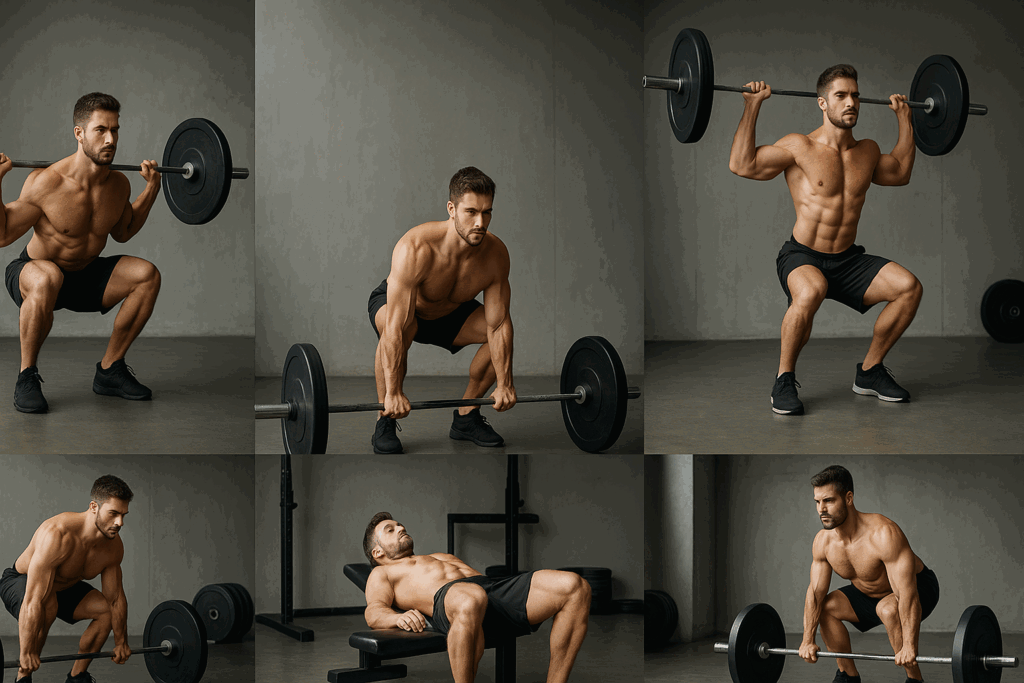
The Role of Hypertrophy in Shaping a Fit Male Physique
Building muscle mass with intention is central to achieving a balanced and symmetrical physique male. While strength underpins performance, hypertrophy refines proportion and density. In practical terms, hypertrophy training introduces higher volumes, varied rep ranges, and intensified mechanical tension to create the microtrauma necessary for muscle growth. For individuals striving to build a perfect male body, understanding and leveraging these principles is essential.
Training for hypertrophy involves working within the 6–12 rep range, with a focus on slow eccentrics, moderate to short rest periods, and metabolic stress. Techniques such as drop sets, supersets, rest-pause training, and tempo manipulation can extend time under tension, promoting sarcoplasmic expansion and increased fiber recruitment. Emphasis on isolated movements—such as preacher curls, lateral raises, and calf raises—allows the practitioner to sculpt details often overlooked by heavy compound-only routines.
Equally critical is the concept of volume accumulation over time. This doesn’t necessitate endlessly increasing training sessions but rather organizing volume within periodized blocks. Over three to five weeks, volume increases strategically, followed by a deload to ensure recovery and muscle potentiation. For those focused on long-term physique development, this cyclical approach prevents plateaus and safeguards connective tissue integrity.
Lastly, hypertrophy is inseparable from nutrition. Macronutrient adequacy—particularly protein intake between 1.6 and 2.2 grams per kilogram of body weight—along with calorie surplus timing, reinforces the anabolic environment. Consistent hypertrophy work, integrated with nutritional discipline, forms the muscle-building cornerstone of exceptional men physiques.
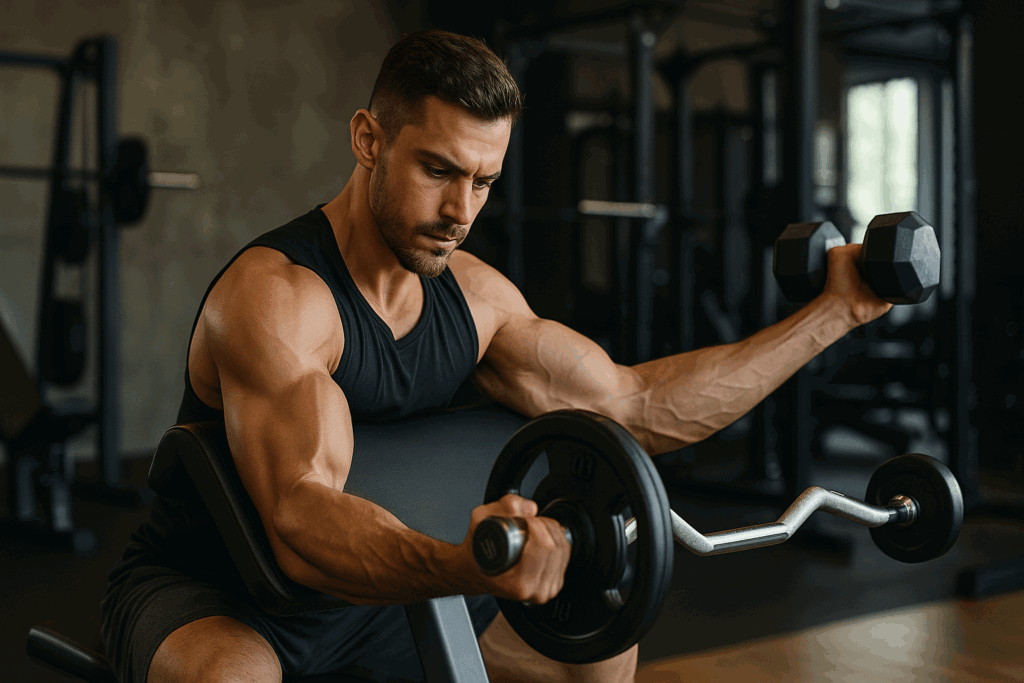
Optimized Programming to Build Perfect Male Body Balance
Programming is more than the sequencing of workouts; it’s the art of aligning training stress with recovery capacity to elicit optimal adaptation. For those seeking to build the perfect male body, training must be intelligent, individualized, and progressive. A weekly program should balance muscle group focus, movement patterns, and neural fatigue, rotating between strength, hypertrophy, and power sessions.
An effective weekly structure might resemble a push-pull-leg format or an upper-lower split, repeated across four to six training days. Strength days center around low-rep, high-intensity lifts; hypertrophy sessions target volume and isolation; and power-focused training emphasizes explosiveness with Olympic-style lifts and plyometrics. Including at least one functional conditioning day promotes cardiovascular fitness and muscular endurance without undermining muscle mass gains.
Within each workout, exercise order matters. Start with the most neurologically demanding lifts, followed by accessory movements, and end with isolation or machine work. Rest intervals should scale with intensity: longer breaks (2–5 minutes) for strength, moderate rests (60–90 seconds) for hypertrophy, and brief pauses (30–60 seconds) for metabolic stress circuits. By periodizing both weekly structure and exercise selection, trainees can stimulate muscle protein synthesis consistently without overtraining.
Tracking variables—such as reps, load, Rate of Perceived Exertion (RPE), and rest times—builds accountability and informs when to increase intensity or volume. Advanced trainees benefit from incorporating autoregulation methods, adjusting daily training loads based on readiness scores or morning heart rate variability. These dynamic methods are particularly effective for experienced lifters aiming to maintain a highly aesthetic and functional fit male physique.
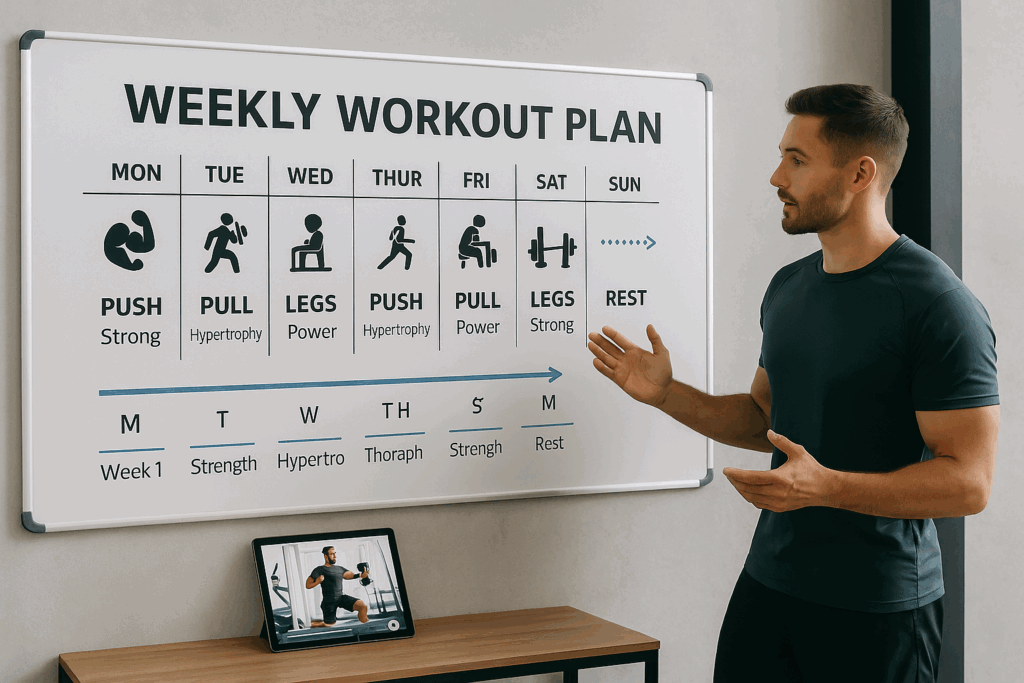
Recovery Science for Sustained Growth in Physique Male Training
Recovery is the unsung hero of physique male transformation. While training stimulates growth, recovery enables it. A comprehensive strength plan must therefore include an equally detailed recovery protocol to manage inflammation, regulate hormones, and facilitate muscular repair. For men physiques in advanced stages of development, inadequate recovery is often the limiting factor in further progress.
First and foremost, sleep remains the most potent recovery agent. Consistent sleep of 7 to 9 hours supports testosterone and growth hormone release, immune function, and central nervous system recovery. Inadequate sleep compromises insulin sensitivity and increases cortisol, making muscle retention and fat loss more difficult. To optimize sleep quality, avoid blue light exposure in the evening, maintain a cool and dark bedroom environment, and develop a consistent bedtime routine.
Nutrition is another pillar of recovery. Post-workout meals should emphasize high-quality protein and fast-digesting carbohydrates to replenish glycogen and support muscle protein synthesis. Supplements like creatine monohydrate, omega-3 fatty acids, and magnesium assist in reducing inflammation, replenishing depleted stores, and enhancing neuromuscular efficiency. For physique male athletes, spacing meals every 3 to 5 hours throughout the day ensures a steady stream of amino acids and micronutrients.
Lastly, active recovery methods enhance circulation, reduce soreness, and prevent stagnation. Low-intensity steady-state (LISS) cardio, mobility drills, yoga, or swimming are excellent options. Foam rolling and dynamic stretching promote tissue pliability and reduce adhesions, while recovery technologies such as compression boots or cold plunge therapy provide additional benefit for advanced trainees. By integrating recovery into the strength blueprint, men physiques can be continually refined without risking regression or injury.
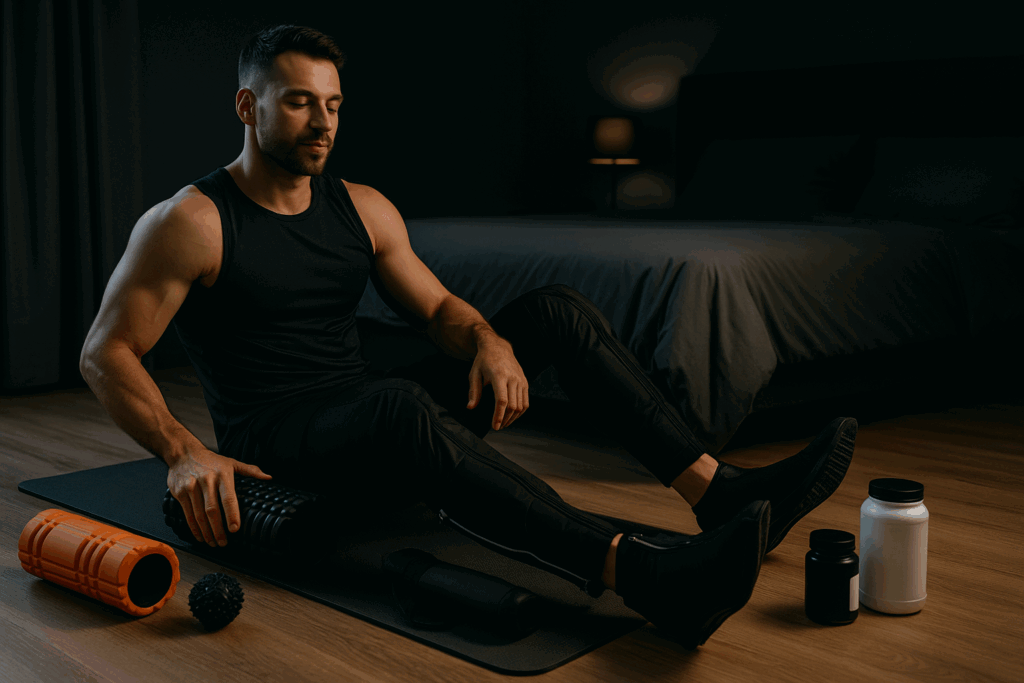
Nutritional Framework for Developing Fit Male Physique Precision
No training plan can compensate for poor nutrition. The fuel that powers performance, supports growth, and regulates hormones is found in food, not just in supplements. For the purpose of sculpting a fit male physique, nutrition must be intentional, data-driven, and adaptable to changing metabolic needs. Macronutrient precision forms the core of this framework, while micronutrients and meal timing provide refinement.
Protein intake must remain high, as it serves as the building block of muscle repair and growth. Prioritize lean sources such as chicken breast, egg whites, turkey, fish, Greek yogurt, and whey protein isolate. Carbohydrates are critical for energy and recovery, especially for individuals training at high intensities five to six days per week. Complex carbs like oats, rice, potatoes, and fruit provide glycogen replenishment, while intra-workout carbs (like cyclic dextrin) can fuel extended sessions.
Dietary fats regulate hormones, particularly testosterone. Healthy sources—including avocados, olive oil, fatty fish, and nuts—support brain function and reduce systemic inflammation. While a slight caloric surplus (around 10–20%) is often necessary to maximize hypertrophy phases, it should be paired with precise meal tracking to avoid excess fat gain.
Meal frequency also impacts nutrient delivery and metabolic rate. Consuming four to six evenly spaced meals throughout the day helps maintain muscle protein synthesis and prevents catabolism. Supplements can fill gaps—especially vitamin D, creatine, and branched-chain amino acids (BCAAs)—but should never replace whole food nutrition. In aligning diet with training, the pathway to an elite men physique becomes both clearer and more achievable.
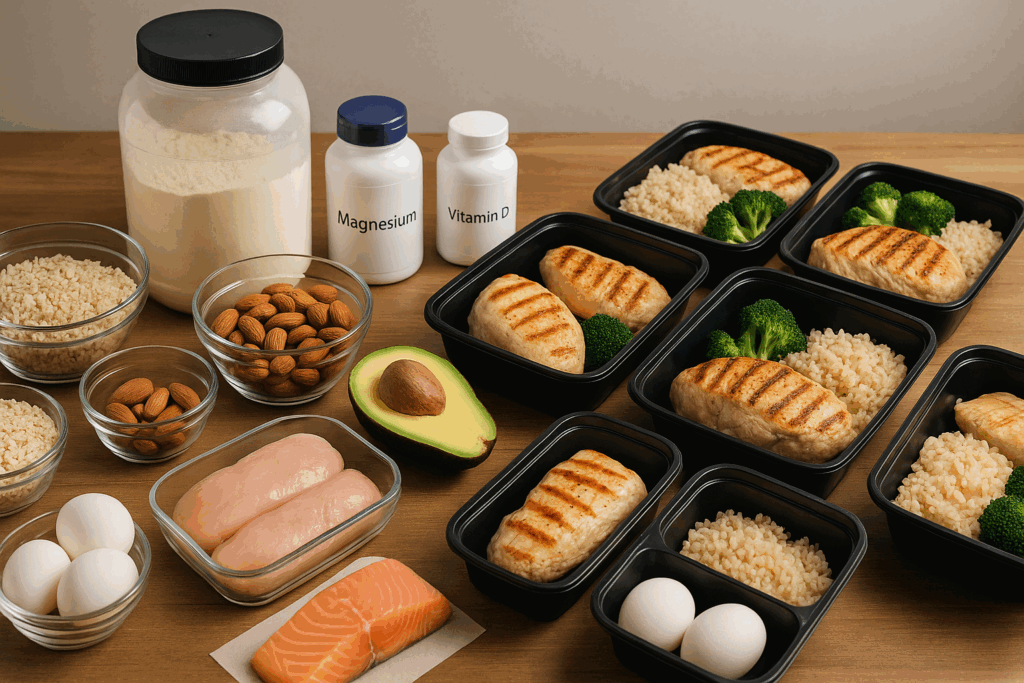
Men Physiques Require Strategic Cardio, Not Endless Treadmill Work
While cardio is often neglected in strength-based pursuits, strategic conditioning is essential for complete men physiques. Cardio supports heart health, improves insulin sensitivity, enhances recovery, and helps maintain leanness during muscle-building phases. However, the old paradigm of endless treadmill jogging must be replaced with intentional, performance-aligned conditioning strategies.
High-Intensity Interval Training (HIIT) and Moderate Intensity Steady-State (MISS) cardio provide effective alternatives. HIIT sessions—such as sled pushes, rowing sprints, or air bike intervals—stimulate both fast-twitch muscle fibers and metabolic adaptation, making them ideal for fit male physique enhancement. Performed two to three times weekly for 15 to 20 minutes, HIIT preserves muscle while improving cardiovascular function.
In contrast, MISS can be integrated on active recovery days to promote circulation and caloric expenditure without CNS fatigue. A 30-minute incline walk or light cycling session complements intense lifting without interfering with recovery. The key is to match cardio type and timing to the current phase of training—more during fat loss phases, less during hypertrophy cycles.
Furthermore, incorporating movement into daily life—through walking, standing desks, or recreational sports—increases total energy expenditure and improves metabolic health. This “non-exercise activity thermogenesis” (NEAT) is critical for those seeking to build perfect male body definitions without excessive training fatigue. With smart implementation, cardio becomes an asset to physique development, not an obstacle.
Hormonal Optimization Strategies for Enhancing Physique Male Potential
The endocrine system plays a pivotal role in muscle growth, fat metabolism, and performance. For anyone seeking to develop a commanding physique male frame, understanding and optimizing hormone function is non-negotiable. Key players include testosterone, growth hormone (GH), insulin, and cortisol—each with distinct, interrelated effects on physique outcomes.
Testosterone is the primary anabolic hormone, responsible for increasing muscle protein synthesis and enhancing strength. Natural optimization involves consistent heavy lifting, adequate sleep, stress management, and dietary fat intake. Zinc, vitamin D, and boron are also linked to higher testosterone levels. GH, released in pulses during deep sleep and high-intensity exercise, promotes tissue repair and lean mass development. Intermittent fasting and sleep quality can positively influence GH output.
Insulin sensitivity is essential for directing nutrients to muscle cells rather than fat. Training improves insulin response, but diet is equally crucial—low-glycemic carbs, fiber, and meal timing all contribute. On the flip side, elevated cortisol from chronic stress or poor sleep hinders muscle retention and promotes fat storage, especially around the midsection.
Mindfulness practices, journaling, breathwork, and structured rest days reduce cortisol and support anabolic balance. In cases where hormone imbalances persist, bloodwork and consultation with a qualified healthcare provider can uncover deficiencies. Optimizing hormones naturally and holistically ensures that men physiques progress sustainably and efficiently.
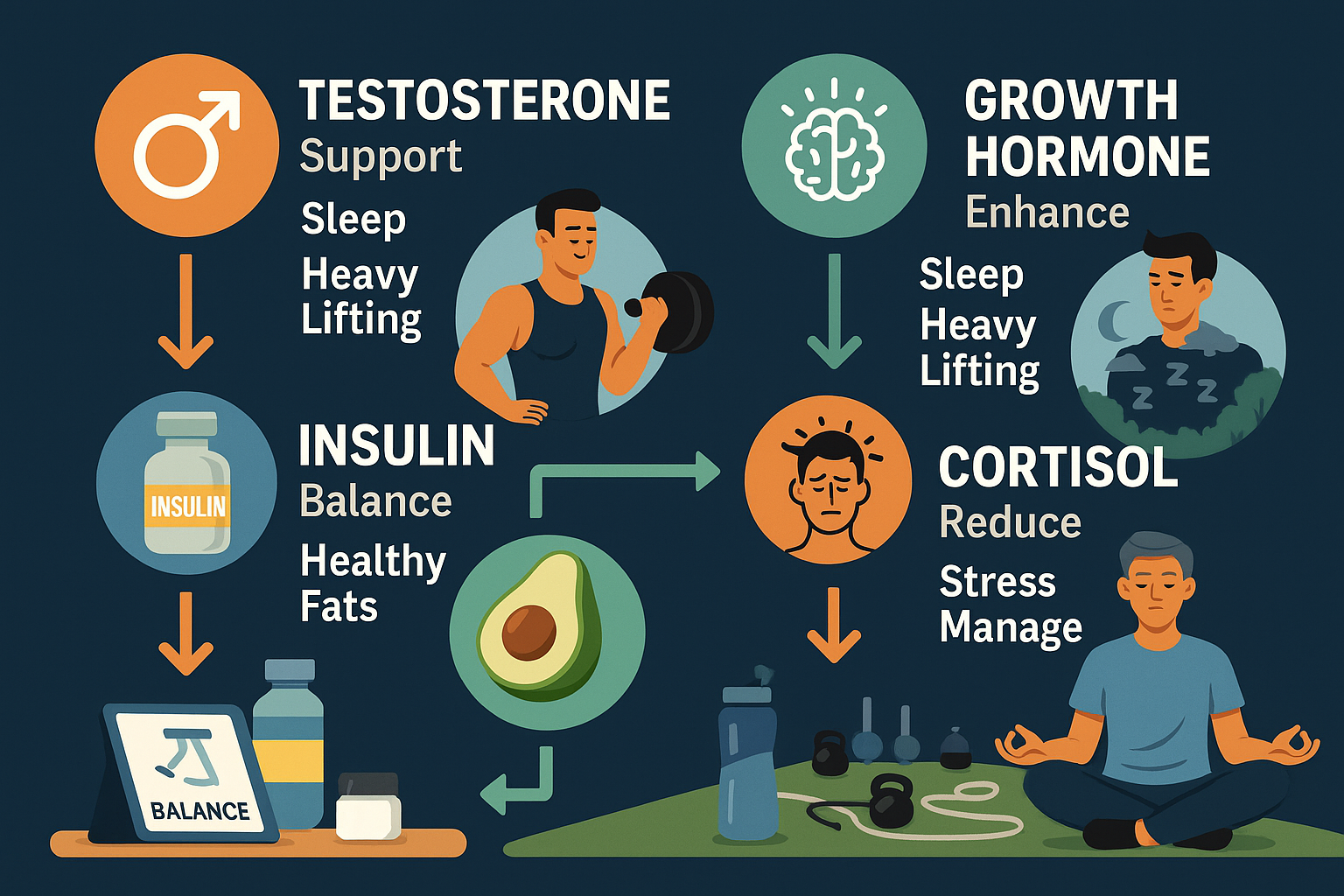
The Psychology of Discipline: Mental Resilience in Physique Development
Aesthetic success begins in the gym but is maintained in the mind. Discipline, mental toughness, and emotional regulation are vital traits for those sculpting advanced men physiques. These qualities govern dietary adherence, training consistency, and recovery compliance—all essential to long-term transformation.
Goal setting must be outcome-based and process-driven. While visualizing the perfect male body is helpful, focusing on daily execution (e.g., hitting macros, completing workouts, sleeping 8 hours) reinforces habits and builds momentum. Journaling progress—both physical and psychological—creates a feedback loop of accountability.
Setbacks are inevitable. Plateaus, minor injuries, or fluctuating motivation can derail even the most advanced lifters. Understanding that progress is nonlinear allows individuals to remain patient and adaptive. Techniques like meditation, cold exposure, and visualization improve stress tolerance and reinforce inner resolve.
Training with partners, coaches, or communities also reinforces psychological accountability. Shared effort enhances consistency, and external feedback identifies blind spots. In the journey to develop commanding men physiques, mindset is often the separator between those who maintain results and those who relapse. Mental fitness, like physical strength, must be trained and tested.

Frequently Asked Questions: Advanced Strategies for Sculpting Powerful Men Physiques
1. How Can Lifestyle Stress Impact the Development of Men Physiques?
Chronic stress significantly impairs the ability to build and maintain elite men physiques by disrupting hormonal balance, particularly by elevating cortisol. Elevated cortisol can suppress testosterone, hinder protein synthesis, and increase visceral fat storage, undermining the results of even the most meticulous training and nutrition plans. Incorporating stress-reduction techniques such as mindfulness meditation, cold therapy, or even structured journaling helps buffer these effects and enhances overall recovery. High-level physique male athletes also benefit from managing stress through time-blocking strategies, digital detoxes, and improved sleep hygiene. Ultimately, developing a fit male physique requires not just physical training, but mental regulation that supports consistent progress.
2. What Role Does Mobility Training Play in Achieving a Fit Male Physique?
Mobility training is often overlooked but is essential for preserving joint integrity and range of motion as muscular development increases. As the body gains mass and density, particularly during hypertrophy phases, mobility may be compromised, leading to stiffness and injury risk. Dynamic stretching before training and targeted mobility flows post-workout ensure fluidity of movement and proper joint alignment. For those seeking to build perfect male body aesthetics, mobility training also enhances performance in compound lifts, allowing for deeper ranges of motion and greater muscle activation. Integrating mobility into a weekly regimen is critical to maintaining both the functionality and visual symmetry of elite men physiques.
3. How Should Macronutrient Ratios Change During Different Physique Goals?
Macronutrient ratios should vary according to the training goal, whether it’s bulking, cutting, or maintenance. To build a perfect male body during a bulking phase, higher carbohydrate intake supports glycogen replenishment and insulin-mediated nutrient delivery, while protein remains consistently high. During cutting, carbs are reduced moderately, and dietary fat is often adjusted to preserve hormonal balance, especially testosterone. A fit male physique benefits from a protein-first strategy in all phases, supported by fiber-rich carbohydrates and anti-inflammatory fats. Tracking individual responses and adjusting weekly based on biofeedback—such as energy, mood, and digestion—ensures nutritional precision.
4. What Are the Most Common Mistakes in Trying to Build a Perfect Male Body?
One of the most frequent mistakes is prioritizing volume over intensity or failing to individualize training programs. Many aspiring physique male athletes fall into the trap of mimicking influencer routines that may not match their training age, recovery capacity, or structural anatomy. Another common error is overtraining without structured deloads, leading to performance stagnation or injury. Nutritionally, underestimating the importance of meal timing and macronutrient balance often sabotages muscle growth and fat loss. Lastly, focusing solely on aesthetics without functional benchmarks can create imbalances, undermining the longevity and sustainability of men physiques.
5. How Can You Maintain Men Physiques During Travel or Off-Cycles?
Maintaining a fit male physique while traveling requires adaptability and minimalism in both training and nutrition. Resistance bands, suspension trainers, and bodyweight circuits can replicate compound movements in hotel rooms or outdoor spaces. Nutritionally, bringing portable protein sources and planning meals around whole food availability helps mitigate muscle loss. Off-cycles are excellent opportunities to improve mobility, enhance cardiovascular fitness, or correct muscular imbalances through corrective exercises. Periodization models that include off-seasons improve long-term physique male progression by allowing physical and mental rejuvenation. With the right mindset and toolkit, sculpted men physiques can be preserved across varying conditions.
6. What Supplement Stacks Support a Fit Male Physique Beyond Basics?
While whey protein, creatine, and omega-3s are foundational, advanced stacks for enhancing men physiques often include less conventional aids. L-carnitine supports fat metabolism and mitochondrial health, especially during cutting phases. Ashwagandha improves stress resilience and may modestly elevate testosterone, supporting recovery. Beta-alanine can enhance muscular endurance during high-rep hypertrophy work, ideal for refining a physique male form. Additionally, adaptogenic mushrooms like cordyceps or lion’s mane support oxygen uptake and mental clarity. Customizing supplement stacks based on individual goals and deficiencies can add precision and acceleration to the pursuit of optimal male physiques.
7. How Can You Balance Strength and Aesthetics Without Compromising Either?
Balancing strength and aesthetics requires strategic program design that alternates between neural and muscular adaptations. Using a concurrent model—where strength days (3-6 reps) are paired with hypertrophy-focused days (8-12 reps)—ensures that both size and power are developed. This also keeps training stimulating and prevents neural burnout. For those working to build the perfect male body, this balance results in dense muscle tissue with practical function. Tracking not just weight lifted but also volume load and time under tension is essential to achieving a well-rounded physique male identity that excels in both form and performance.
8. What Role Does Genetics Play in Sculpting Elite Men Physiques?
Genetics influence muscle shape, insertion points, hormonal response, and baseline metabolic rate, which can all affect the rate and aesthetics of physique development. However, while certain traits like broad shoulders or naturally lean legs may favor a fit male physique, consistent training and nutrition remain the greatest equalizers. Epigenetics, or the ability to influence gene expression through lifestyle and environment, shows that many genetic limitations can be mitigated with long-term habits. That said, understanding one’s genetic predispositions can help tailor exercise selection, recovery protocols, and nutrition plans for better efficiency. Genetics may influence your starting point, but not your endpoint in building superior men physiques.
9. How Should One Adjust Training as They Age to Maintain a Physique Male Standard?
As the body ages, recovery capacity and hormone production decline, requiring a shift in training emphasis. Volume may need to decrease slightly while maintaining or increasing intensity to preserve strength and muscle mass. Recovery techniques such as soft tissue therapy, longer sleep durations, and active mobility become more critical. Joint-friendly exercises, such as using trap bars or cable systems, reduce wear and tear while allowing continued growth. Men physiques developed over years benefit from sustainable practices that prioritize health without sacrificing muscular integrity.
10. Why Are Men Physiques a Reflection of Consistency, Not Perfection?
While the goal to build perfect male body symmetry may drive motivation, the true marker of success is consistent effort, not flawlessness. Photoshopped ideals and social media filters can distort expectations, creating an unhealthy pursuit of unattainable perfection. In reality, the most compelling men physiques are built over years of consistent training, deliberate eating, and habitual recovery. Embracing progress over perfection fosters mental resilience and reduces burnout. Ultimately, what defines a physique male standard is not just visual appeal, but the disciplined lifestyle that sustains it long term.
Conclusion: Sustaining Long-Term Success with Elite Men Physiques
True transformation is not a temporary effort but a lifelong commitment to strength, discipline, and excellence. For those determined to build perfect male body symmetry and maintain a powerful, fit male physique, the process goes beyond aesthetics. It is an evolving dialogue between the mind and body, where progress emerges from intelligent training, disciplined recovery, mindful eating, and adaptive mindset.
By mastering foundational lifts, periodizing hypertrophy and strength cycles, optimizing nutrition, and aligning hormonal health, men physiques can reach unprecedented levels of performance and visual impact. With recovery protocols and mental resilience layered in, these gains become sustainable across decades, not just seasons. Cardio becomes purposeful, not punitive; mindset becomes a tool, not a barrier.
Ultimately, developing a top-tier physique male silhouette is about more than visual appeal. It is about showing up when motivation fades, refining the process continually, and aligning every choice with one’s vision of optimal self-expression. This strength plan is not just a roadmap—it’s a manifesto for those who demand more of themselves, sculpting their potential into the visible and enduring reality of powerful men physiques.





